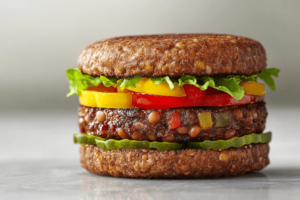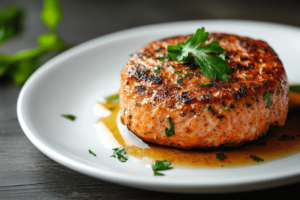Introduction
Burgers are an all-time favorite meal across the United States. They are tasty, convenient, and easy to customize. Yet many people worry about their health when enjoying a juicy patty piled high with condiments. Are burgers always unhealthy? Not necessarily. By making smart choices, you can enjoy burgers and still follow a balanced diet.
In this article, we will explore what is the healthiest meat for burgers. We will also look at different options, such as lean beef, turkey, chicken, bison, fish, and even plant-based choices. Moreover, we will discuss cooking techniques that help preserve nutrients and reduce excess fat. Finally, we will provide answers to common questions about healthy burgers. This way, you can indulge in a delicious meal and still feel confident about your food choices.
What Is the Healthiest Meat for Burgers?
When people hear “burger,” they often think of a traditional beef patty. But not all beef is the same. Some cuts are leaner and more nutrient-packed than others. Moreover, alternative meats can offer protein without a lot of saturated fat. This section will reveal how to select and prepare the most nutritious burger meat. Meanwhile, it will highlight how to keep flavor high and calories in check.
Searching for the Most Nutritious Burger Meat
Lean ground beef can be a good starting point if you want a traditional taste. Look for labels like 90% lean (or higher) when shopping. This means you get protein while limiting extra fat. Also, consider grass-fed beef, which usually contains more omega-3 fatty acids compared to grain-fed options. Grass-fed choices can be more expensive. However, they might be worth the extra cost if you want better quality and a healthier nutrient profile.
Furthermore, it helps to cook patties at the right temperature. This prevents the meat from drying out. A meat thermometer can be useful. Aim for a safe internal temperature but avoid overcooking. As a result, you get a juicy burger without loads of extra oil or cheese.
Why Focus on Lean Meat?
Lean meat keeps saturated fat levels lower. That is important for heart health. Too much saturated fat can raise bad cholesterol levels. Additionally, lean cuts leave more room in your diet for healthy fats from sources like avocado or nuts. This does not mean you must stop eating flavorful burgers. Instead, consider balancing the types of fat and the total amount of fat in each serving.
Choosing lean meat can also help control your calorie intake. Each gram of fat contains nine calories. Meanwhile, protein and carbohydrates provide only four calories per gram. By opting for lean ground beef or a similar low-fat option, you can enjoy a filling meal without extra calories sneaking in. Besides, you can add colorful toppings like lettuce, tomato, onion, or even sliced peppers to add volume and vitamins.
The Benefits of Grass-Fed Options
Grass-fed beef often gets praise for its nutritional profile. It may contain more omega-3s, which are vital for brain and heart health. Also, grass-fed meat might have higher amounts of vitamins and antioxidants. Many people say grass-fed beef tastes richer. On the downside, it can be pricier and sometimes less marbled. Consequently, the patties can turn out drier if you overcook them.
Nevertheless, grass-fed beef remains a strong pick if you want a nutrient-dense burger. If cost is a concern, you can mix grass-fed ground beef with a leaner, more affordable option. This way, you keep some benefits of grass-fed meat without breaking your budget. Moreover, you can also top your burger with healthy extras like leafy greens or grilled veggies to further boost nutrition.
Minimizing Fat Without Losing Flavor
It can be challenging to cut down on fat but still savor a tasty burger. One easy way is to use fresh herbs and spices. For instance, mix garlic powder, onion powder, paprika, and a pinch of chili flakes into your ground meat. In addition, try adding a dash of Worcestershire sauce or low-sodium soy sauce for depth. These small additions can enhance flavor without piling on calories or salt.
You should also pay attention to cooking methods. Baking or grilling the patty can help drain away some fat. Another trick is to press gently on the burger when flipping it to remove excess grease. Avoid pressing too much, though, or you risk losing natural juices. Keep your patties thick enough to retain moisture, but thin enough to cook quickly and evenly. Thus, you end up with a burger that strikes the perfect balance between health and taste.
Considering Turkey and Chicken for Healthier Burgers
Sometimes, the healthiest meat for burgers might not be beef at all. Turkey and chicken have grown in popularity for health-conscious burger lovers. They usually contain less saturated fat than beef, especially if you select skinless, lean ground varieties. Although some people find these options drier, the right cooking methods and seasonings can produce delicious results.
Nutritional Advantages of Poultry
Turkey and chicken are loaded with protein. Both meats are also lower in calories and fat compared to standard ground beef. If you choose ground turkey breast, you reduce saturated fat content even further. Some people prefer the delicate taste of poultry patties because they work well with various herbs. For instance, you can add basil, thyme, or rosemary to infuse fresh aroma and flavor.
Additionally, turkey contains the amino acid tryptophan, which can support mood and restful sleep. Meanwhile, chicken is a great source of B vitamins, which help keep your energy levels steady. Hence, both are excellent choices if you want variety and lean protein.
Tips for Preparing Poultry Patties
Poultry patties can dry out fast because they have less fat. Therefore, it is important to prevent overcooking. A good rule of thumb is to cook them until the meat reaches 165°F. Do not rely only on color, since turkey or chicken can appear white even when undercooked. Use a meat thermometer for accuracy.

Also, add small diced onions or bell peppers to the ground poultry to lock in moisture. You can include a bit of healthy fat, like olive oil, in the mixture. Yet do not go overboard. Keep the patty thickness consistent to ensure even cooking. If you find the flavor lacking, top your burger with ripe avocado slices. Avocado gives creaminess and heart-healthy fats. Overall, turkey and chicken burgers can be a tasty, lighter alternative to beef.
Exploring Plant-Based Alternatives
Meat does not have to be the only way to enjoy a delicious burger. Plant-based patties are now popular in grocery stores and restaurants. Some are made with ingredients like beans, peas, soy, or a blend of vegetables and grains. While these options might not be what you picture when you think of a burger, they can be very flavorful. Moreover, they often contain fiber and phytonutrients that promote good health.
Are Plant-Based Patties Healthy?
Plant-based patties can be healthy if they are made with whole-food ingredients like lentils, black beans, quinoa, or brown rice. Many brands fortify their products with vitamins and minerals. However, not all plant-based burgers are created equal. Processed varieties might be high in sodium or added oils. Consequently, it is wise to read labels and choose options with fewer artificial ingredients.

One advantage is that plant-based burgers contain no cholesterol. That makes them a popular choice for those watching their heart health. They also provide a different texture and taste, which can keep your meal plan interesting. If you make them at home, you can control the salt and spice levels. You can also experiment with various flavor combinations, such as roasted mushrooms or grilled onions mixed into the patty. As a result, you may discover new favorite recipes that support a healthier lifestyle.
Fish Burgers for Omega-3 Boost
If you love seafood, a fish burger can be a great way to get beneficial fats. Salmon, tuna, and other fish contain omega-3 fatty acids. These help lower inflammation and support heart health. Although fish burgers are less common than beef or turkey burgers, they offer a fresh, light taste. Furthermore, fish cooks quickly, making them ideal for weeknight meals.

Salmon and Tuna as Burger Alternatives
Salmon is one of the best-known sources of omega-3s. It also provides high-quality protein and essential minerals. When forming salmon patties, you can use fresh fillets or canned salmon. Combine it with whole-wheat bread crumbs, egg, and your favorite seasonings. Because salmon is already oily, you may not need extra fat. Thus, you can keep calories in check while reaping health benefits.
Tuna burgers are another tasty option. Choose solid white albacore tuna for a meatier texture. Mix in diced celery or scallions for crunch. Likewise, incorporate spices to boost flavor. Cook these patties on a hot grill or stovetop for a quick protein fix. For a finishing touch, top with tangy yogurt sauce or fresh tomatoes. Each bite offers a burst of flavor without too many extra calories.
Bison and Other Game Meats
For those seeking a lean yet flavorful alternative, bison might be the healthiest meat for burgers. Often, bison is lower in fat and calories than standard beef. It also has a robust, slightly sweet taste. Furthermore, some people find bison easier to digest. In addition to bison, game meats like venison can provide unique flavors and a lean profile. Though these might not be available at every supermarket, they are worth considering if you want variety.
Why Choose Bison or Venison?
Both bison and venison are known for their lower fat content. They often contain more protein per ounce than other meats. Therefore, you can feel satisfied without consuming too many calories. These meats are also rich in iron and B vitamins. Iron helps transport oxygen in your bloodstream, which is crucial for energy and overall vitality.
When cooking bison or venison, remember that these meats can dry out quickly. Their low fat content means they cook faster. Thus, keep a close eye on them to avoid a tough patty. Many chefs suggest cooking these burgers no more than medium-rare to medium. Consequently, you get a tender and juicy bite. For an extra health boost, layer your burger with spinach, tomato, and a sprinkle of cheese or a lighter sauce.
Cooking Techniques for Healthier Burgers
How you cook your burger can be as important as the meat you choose. Even a lean cut can turn into a high-calorie dish if you fry it in too much oil or smother it with cheese. Fortunately, there are simple cooking methods that keep your patty tasty without a huge calorie load.
Baking
Baking your patties can save time and reduce cleanup. Place burgers on a baking sheet lined with parchment paper or foil. Bake at 375°F to 400°F, depending on your oven. For lean meats, consider brushing them with a tiny bit of oil or placing a small dish of water in the oven. This prevents them from drying out. Turning the patties halfway ensures even cooking.
Moreover, baking lets you prepare other sides at the same time. You can roast sweet potato wedges or broccoli on a separate tray. This way, you create a balanced meal full of color and nutrients. Baking also keeps added fats to a minimum. After cooking, you can pat the burgers with paper towels to remove any visible grease.
Grilling
Grilling remains a classic way to cook burgers. It imparts a smoky flavor that many love. At the same time, it allows excess fat to drip away from the patty. One tip is to preheat your grill properly to prevent sticking. Also, lightly oil the grates or use nonstick spray. That way, you minimize the risk of ripping your burger apart when flipping it.
When grilling lean meats like turkey, chicken, bison, or salmon, pay close attention to cook times. Lean patties benefit from medium heat instead of high heat. This approach avoids charring the outside too quickly. An internal thermometer is a good ally here. It helps you remove the burgers at the right doneness level without guesswork.
Pan-Seared or Air-Fried
Another option is pan-searing. Use a nonstick skillet or cast-iron pan with a thin layer of oil. This technique creates a nice crust on the outside while locking in juices. For leaner meats, some cooks add onions or mushrooms to help retain moisture and add a savory touch. While pan-searing, try using medium-high heat to achieve a golden-brown finish without burning.
Air-frying is also growing in popularity. It allows you to cook burgers with hot air circulation, leading to a crispy exterior and tender interior. You only need a light spritz of oil. This method is especially handy for turkey or chicken burgers that tend to stick or fall apart. Air fryers also shorten cooking times, which is helpful on busy days.
Healthier Toppings and Buns
The meat choice is central, but toppings and buns can make or break your burger’s nutrition. Traditional toppings like bacon and extra cheese add saturated fat. Instead, consider fresh vegetables, low-fat cheese, or even grilled pineapple for sweetness. Avocado, hummus, or tzatziki sauce can replace high-calorie spreads like mayo. These options provide healthy fats or extra protein.
When it comes to buns, whole-grain varieties offer more fiber and nutrients. You can also try lettuce wraps or portobello mushrooms as a bun substitute if you want fewer carbs. Even small tweaks to condiments and breads can significantly improve the health factor of your burger. In short, pair a lean patty with lighter toppers to build a meal that tastes great and supports your health goals.
Frequently Asked Questions
Why are Five Guys burgers unhealthy?
They tend to be large and include more fat and calories. Plus, toppings and sides like fries can add extra sodium and saturated fat.
What is the best blend of meat for hamburgers?
Many prefer an 80/20 blend (80% lean, 20% fat) for flavor. But a leaner blend, such as 90/10, can offer a healthier profile without losing too much taste.
Is it possible to make a healthy burger?
Yes, it is possible. Choose lean meats or plant-based patties, add fresh toppings, and select whole-grain buns to boost nutrients and reduce fat.
What makes a burger unhealthy?
High levels of saturated fat, large portion sizes, refined buns, and sugary or creamy sauces can make burgers unhealthy if eaten too often.
Conclusion
Burgers can be part of a balanced diet. First, focus on the healthiest meat for burgers, such as lean beef, poultry, or fish. Or try plant-based or game meats for unique tastes and textures. Then, opt for smart cooking techniques that reduce extra fat. Also, pay attention to toppings and buns. Small changes can lead to major improvements in nutrition and flavor. With these tips, you can enjoy a burger that fits your lifestyle and supports your well-being.

